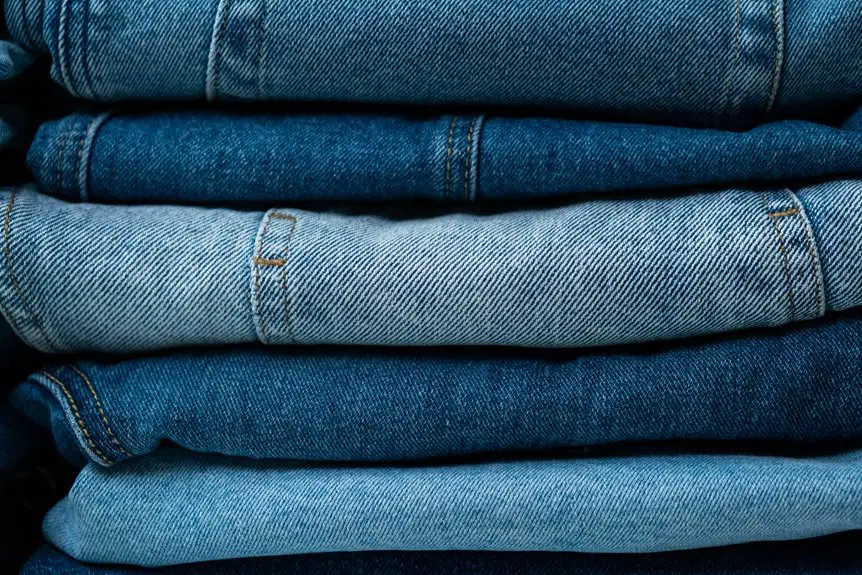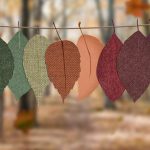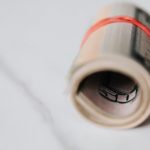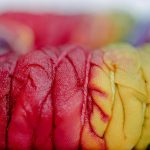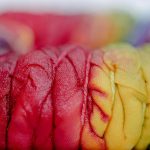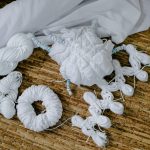To master tie-dye folding and binding, start by prepping natural fabric—wash, soak in soda ash, and keep it damp. Use strong rubber bands or string to bind your carefully folded fabric—try spiral or accordion folds for sharp designs. Apply dye precisely with squeeze bottles, ensuring tight binding to prevent bleeding. Protect your workspace and wear gloves. Once bound and dyed, wrap in plastic to set colors. Keep going, and you’ll reveal advanced techniques for stunning, lasting patterns.
Table of Contents
Key Takeaways
- Prepare fabric by washing, dampening, and soaking in soda ash for better dye absorption before folding and binding.
- Use folding techniques like spiral, accordion, and diagonal folds to create distinct tie-dye patterns and sharp creases.
- Secure fabric tightly with rubber bands or string to create resist areas and prevent dye bleeding for clear designs.
- Apply dye with squeeze bottles precisely, saturating each section separately while keeping folds tightly bound.
- After dyeing, wrap fabric in plastic to retain moisture, then wash gently in cold water and air dry to preserve colors.
Understanding the Basics of Tie-Dye Fabric Preparation
Before you begin folding and binding your fabric, you need to prepare it properly to guarantee vibrant, lasting colors.
Start by washing your fabric to remove any dirt, oils, or sizing that could block dye absorption. Use a mild detergent and skip fabric softeners, as they can interfere with the dye.
Begin by washing your fabric with mild detergent to remove oils and dirt, avoiding fabric softeners to ensure proper dye absorption.
After washing, keep your fabric damp but not soaking wet; this helps the dye spread evenly when applied.
Next, soak your fabric in a soda ash solution for about 15-20 minutes. Soda ash raises the pH level, improving dye bonding and intensifying colors.
Once soaked, wring out excess liquid gently to avoid unwanted dye pooling.
Prepping your fabric this way sets the foundation for bold, well-defined tie-dye patterns.
Essential Tools and Materials for Tie-Dye Folding and Binding
To get started with tie-dye folding and binding, you’ll need some essential supplies like fabric, rubber bands, and gloves.
Choosing the right fabric, typically natural fibers like cotton, makes a big difference in how your colors turn out.
Having the right tools on hand will help you create clean folds and secure bindings for vibrant, lasting designs.
Must-Have Tie-Dye Supplies
Five essential tools will make your tie-dye folding and binding process smoother and more precise. First, grab a set of strong rubber bands—they hold your fabric tightly and create those signature patterns.
Next, use plastic squeeze bottles for easy, controlled dye application. You’ll also want disposable gloves to keep your hands clean and safe from stains.
A large plastic table cover protects your workspace from dye spills and messes. Finally, have a spray bottle filled with water handy to dampen fabric or blend colors subtly.
These supplies are must-haves to get started confidently. With these tools ready, you can focus on your folding techniques and binding patterns without any hassle, making your tie-dye projects fun and successful every time.
Choosing Fabric and Tools
Having the right tools on hand sets you up for success, but the fabric you choose plays an equally important role in how your tie-dye turns out. Opt for natural fibers like cotton, rayon, or silk—they absorb dye better and produce vibrant colors. Avoid synthetic fabrics as they often resist dye.
When picking your tools, grab rubber bands, string, or zip ties to secure folds tightly and create sharp patterns. A plastic squeeze bottle helps you apply dye precisely, while gloves protect your hands from stains. Don’t forget a plastic table cover or garbage bags to keep your workspace clean.
Finally, have a plastic bag or plastic wrap ready to wrap your fabric while it sets. With these essentials, you’ll be ready to create stunning tie-dye designs.
How to Choose the Right Fabric for Tie-Dye Projects
Choosing the right fabric can make or break your tie-dye project, so you want to pick materials that absorb dye well and hold color vibrantly.
Natural fibers like cotton are usually your best bet because they soak up dye better than synthetic fabrics.
Let’s look at the different fabric types and what qualities make them ideal for tie-dyeing.
Fabric Types Overview
Selecting the right fabric sets the foundation for your tie-dye project’s success. Natural fibers like cotton, rayon, and silk absorb dye best, giving you vibrant, long-lasting colors.
Cotton is a favorite for beginners due to its availability and ease of use. Rayon offers a silky feel and brilliant hues but requires careful handling. Silk creates rich results but can be tricky since it’s delicate.
While synthetic fabrics like polyester and nylon resist most dyes, you can use special dyes designed for them if you want to experiment. Blends can be unpredictable, so test a small swatch first.
Choosing your fabric wisely saves you frustration and helps your designs come to life just as you imagine. Keep this in mind when picking your base for tie-dye.
Best Fabric Qualities
Understanding fabric qualities can make a huge difference in how your tie-dye turns out. You want a fabric that absorbs dye well and holds color vibrantly.
Natural fibers like cotton, rayon, and hemp are your best bets because they soak up dye easily, giving you bright, lasting patterns. Avoid synthetic fabrics like polyester—they repel dye and result in dull colors.
Look for tightly woven fabrics; they allow for sharp designs when you fold and bind. Also, consider the fabric’s weight: lighter fabrics absorb dye quickly but may bleed, while heavier ones offer more control.
Pre-washing your fabric removes sizing and helps the dye adhere better. Choosing the right fabric guarantees your tie-dye project looks vibrant and professional every time.
Step-by-Step Spiral Fold Technique
To create the classic spiral pattern, start by laying your fabric flat and pinching its center point firmly.
Twist the fabric around this center, spinning it into a tight spiral. Keep twisting until the entire piece forms a compact disc shape.
Spin the fabric tightly from the center until it forms a neat, compact spiral disc.
Once twisted, secure the spiral with rubber bands crisscrossing over the fabric, dividing it into sections for dye application.
Visualize the process:
- Imagine the fabric swirling like a cinnamon roll as you twist
- Picture rubber bands radiating like spokes on a wheel, holding the shape
- See the sections ready for vibrant colors to be applied
This method guarantees your spiral pattern has crisp, defined lines and a balanced design once dyed and unfolded.
Mastering the Accordion Fold for Bold Stripes
To create bold stripes with the accordion fold, start by folding your fabric back and forth in even, narrow pleats.
Make sure to align the edges carefully to keep your stripes consistent.
With practice, you’ll achieve clean, even lines that make your design pop.
Accordion Fold Basics
Mastering the accordion fold starts with creating even, crisp pleats that run parallel across your fabric. You’ll want to fold the fabric back and forth like a paper fan, keeping each fold consistent in width.
This technique helps you achieve bold, clean stripes in your tie-dye design. Focus on maintaining sharp edges and uniform spacing as you work.
To visualize the process, picture:
- A concertina fan, with neat, repetitive folds creating a rhythmic pattern
- Thin, stacked layers of fabric that resemble the ridges of an accordion bellows
- Smooth, parallel lines that guide the dye placement for striking contrast
Aligning Fabric Edges
Although folding the fabric evenly is essential, aligning the edges precisely guarantees your accordion folds lay flat and your stripes come out sharp.
Start by laying your fabric on a flat surface, smoothing out any wrinkles. Pinch the edge of the fabric and fold it over carefully, matching the top and bottom edges as closely as possible. Use your fingers to press down along the fold, ensuring the edges stay aligned.
Work your way down the entire length, keeping each fold consistent in width. If the edges don’t line up, your stripes can become uneven or distorted.
Taking the time to align edges meticulously sets the foundation for bold, clean stripes, making your tie-dye project stand out with professional-looking results.
Achieving Even Stripes
When you fold your fabric into an accordion, keeping each fold even is essential for creating bold, consistent stripes.
Start by laying your fabric flat and smoothing out wrinkles. Use a ruler or measuring tape to guide your folds, aiming for equal widths throughout. Pinch each fold firmly to maintain sharp creases, which help the dye resist and form clear lines.
Visualize the process:
- Crisp, uniform folds stacked like piano keys
- Sharp edges creating stark contrasts between dyed and undyed areas
- A repeating pattern of straight, parallel lines across the fabric
Creating Crisp Circles and Bullseye Patterns
To create crisp circles and bullseye patterns, start by pinching the fabric where you want the center of your design to be. Pull this point upward to form a cone shape.
Next, use rubber bands to bind the fabric at evenly spaced intervals along the cone, starting from the tip and moving downward. Each section between the rubber bands will become a distinct ring of color. Make sure the bands are tight to prevent dye from bleeding between sections.
When you apply dye, focus on saturating each segment separately, using contrasting colors for a bold effect. After dyeing, let the fabric set according to the dye instructions before rinsing.
This method helps you achieve clean, defined circles and the classic bullseye look every time.
Geometric Shapes: Triangles, Squares, and Diamonds
Building on the precision required for crisp circles and bullseye patterns, creating geometric shapes like triangles, squares, and diamonds demands careful folding techniques.
You’ll start by folding your fabric into sharp, clean lines, ensuring symmetry. These shapes rely on exact creases to guide dye placement and achieve bold, defined edges.
To get you visualizing:
- Fold your shirt diagonally to form a perfect triangle, doubling or tripling for depth.
- Create square patterns by accordion folding fabric in parallel lines, then folding perpendicular to form a grid.
- For diamonds, fold the fabric into a diamond shape by combining diagonal and horizontal folds carefully.
Mastering these folds sets a strong foundation for striking geometric tie-dye designs.
Using Rubber Bands and String for Effective Binding
Rubber bands and string play an essential role in securing your folds and controlling dye application for crisp, vibrant patterns. When you tightly bind the fabric with rubber bands, you create resist areas that prevent dye from reaching certain sections, forming clear lines and shapes.
Tightly bound rubber bands create resist zones for crisp, vibrant tie-dye patterns with clear lines and shapes.
String, especially when wrapped firmly and knotted, can produce finer, more intricate details compared to rubber bands. Use rubber bands for broad, bold patterns and string for delicate, precise designs.
Be certain to stretch rubber bands just enough to hold folds securely without cutting into the fabric. When using string, wrap multiple times for tight resistance but avoid overly tight knots that might damage the fibers.
Proper binding guarantees your tie-dye results are sharp, colorful, and visually striking.
Combining Multiple Folding Techniques for Unique Designs
When you combine multiple folding techniques, you release endless possibilities for creating one-of-a-kind tie-dye patterns. Mixing folds like accordion pleats with spirals or crumples adds layers of complexity that make your design pop.
Start by folding your fabric using one method, then add another fold perpendicular or diagonally for contrast. Secure each stage with rubber bands or string to keep the shapes intact during dye application.
Try these combinations to spark your creativity:
- Accordion fold followed by a spiral twist for dynamic circular waves
- Triangular folds layered with scrunching for textured bursts
- Fan folds combined with pinwheel spirals for bold, geometric swirls
Experimenting this way helps you craft vibrant, intricate designs that stand out every time.
Tips for Preventing Dye Bleeding and Achieving Sharp Lines
Combining folding techniques creates exciting patterns, but keeping those designs crisp requires careful dye application.
To prevent dye bleeding, start by tightly binding your fabric with rubber bands or string. The tighter the binding, the sharper the lines will be. Use a squeeze bottle to apply dye precisely, avoiding over-saturation, which causes colors to run into each other. Work quickly but carefully to prevent the dye from pooling.
Also, consider applying a resist, like wax or a thickened dye, along edges where you want clear separation. After dyeing, wrap your piece in plastic to keep moisture in and allow colors to set without spreading.
Caring for Your Finished Tie-Dye Creations
Although the dye is set, proper care guarantees your tie-dye creations stay vibrant and sharp over time. To keep your colors popping, wash your garments gently and avoid harsh detergents.
Always turn your tie-dye inside out before washing to protect the design. Dry your pieces naturally when possible, as high heat from dryers can fade colors prematurely.
Here’s a quick care checklist to keep your tie-dye looking fresh:
- Wash in cold water with mild detergent to prevent color fading
- Avoid bleach and fabric softeners that can damage the dye
- Air dry or tumble dry on low heat to preserve fabric integrity
Frequently Asked Questions
Can I Use Tie-Dye Techniques on Synthetic Fabrics?
You can tie-dye synthetic fabrics, but results vary since they don’t absorb dye like cotton. Use special dyes like disperse dyes for synthetics, and expect colors to be less vibrant or require heat setting for best results.
How Long Should I Let the Dye Set Before Rinsing?
Think of the dye as a secret letter needing time to settle in its envelope—wait at least 6 to 8 hours before rinsing. This patience locks in vibrant colors, ensuring your design truly shines and lasts.
Are There Eco-Friendly Dyes Suitable for Tie-Dyeing?
You’ll find plenty of eco-friendly dyes for tie-dyeing, like fiber-reactive and natural plant-based options. They’re less toxic, biodegradable, and safe for your skin and the environment, making your projects greener and fun.
Can I Wash Tie-Dye Items With Regular Laundry Detergent?
Washing tie-dye feels like preserving a rainbow’s soul. You can use regular detergent, but choose a gentle, color-safe one to keep hues vibrant. Avoid bleach and wash in cold water to protect your masterpiece.
How Do I Fix Uneven or Patchy Dye Results?
You can fix uneven dye by reapplying dye to the patches, using a spray bottle or brush. Let it sit longer, then rinse carefully. Next time, apply dye evenly and soak fabric thoroughly before folding.
- Disc Golf Dyeing 101: The I-Dye Poly Technique - July 13, 2025
- An In-Depth Look at the Low-Dye Arch Support Taping Method - July 13, 2025
- Solving the “Resist Dyeing Technique” Crossword Clue (Batik/Ikat) - July 13, 2025

